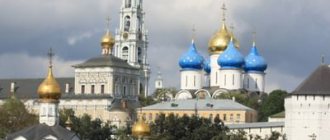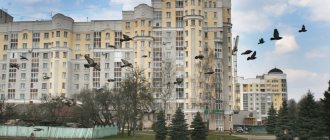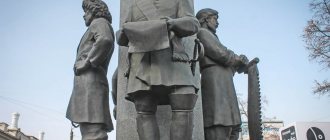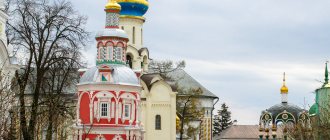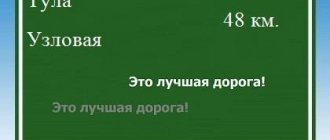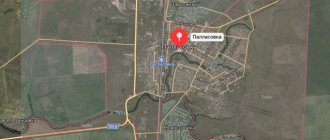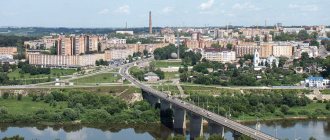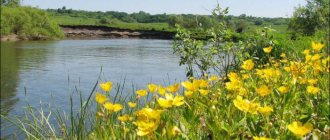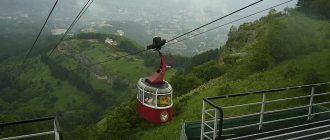The Belgorod region is located in the southwest of Russia, approximately seven hundred kilometers from Moscow and belongs to the Central Federal District. The regional center is the city of Belgorod. The region consists of twenty-one districts. The total population for 2022 is 1,547,532. In 2022, the region celebrated 65 years since its founding.
What holiday is it today?
January 22, 2022, Saturday
Today are holidays, events: Day of Unification of Ukraine Tomorrow: Premiere of the opera “Eugene Onegin” at the Bolshoi Theater
Today is the Orthodox holiday: Martyr Polyeuctus. St. Philip, Metropolitan of Moscow and All Russia, wonderworker... Tomorrow: St. Gregory, Bishop of Nyssa. Venerable Markian the presbyter. Venerable Dometian, Bishop of Melitino. St. Paul of Komel, wonderworker, student of St. Sergius of Radonezh. Saint Theophan, the Recluse of Vyshensky...
Today is a national holiday: St. Philip's Day... Tomorrow: Gregory - Summer Guide...
Seasons
Seasons, four periods of the year (spring, summer, autumn and winter) characterized by certain average temperatures. The period during which the Sun passes through one of these sectors is called the season. Spring in the Northern Hemisphere and autumn in the Southern Hemisphere begin when the Sun passes through the initial circle of declination and its right ascension is 0° (vernal equinox). Summer in the Northern Hemisphere and winter in the Southern Hemisphere occur when the sun's right ascension is 90° (summer solstice). Autumn in the Northern Hemisphere and spring in the Southern Hemisphere begin when the sun's right ascension is 180° (autumnal equinox). The beginning of winter in the Northern Hemisphere and summer in the Southern Hemisphere is considered to be the winter solstice, when the direct ascension of the Sun is 270°... Next: Seasons. Russian folk calendar. Monthly words...
Photo reviews of the region
- Belgorod region. Harvest. Chistoprudov 2009
- Belgorod region. Grain storage and processing. Chistoprudov 2009
- Belgorod region. Field cultivation and equipment repair. Chistoprudov 2009
- Lebedinsky mining and processing plant. Part 1. Chistoprudov 2009
- Lebedinsky mining and processing plant. Part 2. Chistoprudov 2009
- Belgorod region. Sowing. Chistoprudov 2009
- KU-800. Chistoprudov 2011
- Big explosion in the big quarry Chistoprudov 2012
- Prokhorovka and Alekseevka. bigpotap 2015
Folk calendar about every day
Every day one season always replaces another and this determines a person’s way of life. In connection with this, a folk calendar was formed in which there were practically no nameless, unmarked days. Every day was special, had its own purpose. All this was determined by climate conditions and astrological phenomena.
A calendar is a system for counting periods of time. The first calendars arose a long time ago, in ancient times, because there was a need to measure time. The word calendar comes from the Latin words caleo - to proclaim and calendarium - debt book. This is due to the fact that in Ancient Rome the beginning of each month was especially proclaimed, and because it was customary to pay debts on the first day of the month. Different peoples counted time differently. Some calendars are based on the changing phases of the moon - lunar calendars; in others - the change of seasons - sunny; in others, the length of the year was coordinated with the change of seasons, and the counting of months was associated with the phases of the Moon. Such calendars are called lunisolar.
In Rus', the calendar was called a monthly calendar. Every day, the month book covered the entire year of peasant life, “describing” day by day, month after month, where each day had its own holidays or weekdays, customs and superstitions, traditions and rituals, natural signs and phenomena. The cyclical nature of the calendar is reminiscent of human life, where spring is youth, summer is heyday, autumn is the time of harvesting fruits (it’s good if there are some, otherwise you can live your life without collecting fruits), winter is the time of wisdom and peace. This cyclicality and rhythm determined the way of life of the farmer. The folk calendar was an agricultural calendar, which was reflected in the names of the months, folk signs, rituals and customs. Even the determination of the timing and duration of the seasons is associated with real climatic conditions. Hence the discrepancy between the names of the months in different areas... Next: Folk calendar...
Natural monuments of the Belgorod region
The territory of the Belgorod region is very beautiful and well-groomed, and has a huge variety of natural monuments. Belgorod is filled with a huge number of ponds, swamps, springs, and mineral waters. All these natural attractions are spread throughout the region, and some of them are a must-see.
Belogorye Nature Reserve
The Belogorye Nature Reserve is one of the most visited places by tourists. Its total area is 2000 hectares. This reserve, founded in 1999, contains five unique areas. According to reviews from tourists, you should definitely visit these places.
Krapivenskoe settlement
The Krapivenskoye settlement is an archaeological monument, located on the hill of the right bank of the Koren River. In the 5th century BC. Scythian tribes lived here, which was proven by excavations carried out in those places. Afterwards, a tribe of northerners settled on their territory, one of the tribes that formed Kievan Rus. If you visit the local history museum, you can see many exhibits of ancient Rus'.
Museum dedicated to the Battle of Kursk
Another attraction of the Belogorye Nature Reserve is the Battle of Kursk Museum. This diorama museum was opened in 1985 as a sign of victory in the Second World War. Most of the exhibits on display are elements of the Battle of Kursk.
Sundial
The most recognizable symbol of the Belgorod city center is the sundial installed in 2008. They were created based on the prototype of medieval illustrations. The diameter of the watch is 11 m with an error of only a few minutes (which is surprising for this type of device). Another feature of this watch is that it works at night! With the onset of darkness, the LED display on the circle lights up - the starry sky.
Warfare
Military Affairs is a museum of medieval military affairs. It's a must visit. There you can not only see, but also hold medieval weapons in your hands.
Gallery in the Belogorye nature reserve
An amazing place in the Belgorod region, or rather the Belogorye Nature Reserve, photo art gallery named after. V.A. Sobrovin (famous photographer). The gallery was opened in 2008. This interesting place has collected many original works by contemporary photographers. The gallery organizes not only exhibitions of photographic works, but also engages in training photographers, publishing and research activities.
Prokhorovskoe field
Perhaps the most famous area in the region. It is famous for tank battles of the Second World War. In 1995, as a sign of respect for the tragic events, a memorial complex was erected, representing various objects that perpetuate the feat of Soviet soldiers during the Second World War. The most important monument of the Prokhorovsky field is the Belfry. It was erected on May 3, 1995, to a height of 252 m. Not far from the Belfry there is an exhibition of armored vehicles from the Second World War.
The museum called “The Third Military Field of Russia” was founded in 2010. This special gallery is located on an area of more than 2000 m². This exhibition collected all the photographs, documents, weapons and many memorabilia from the Second World War. Modern technologies, installations and reconstructions make it possible to recreate a complete picture of those times.
Monastery Forest
Previously, this forest was called Tract Meadow. According to legend, it was here that the icon of the Mother of God was discovered. This spiritual place allows you to be alone with nature, truly calm down, and escape from the everyday hustle and bustle. Tourists enjoy visiting this forest.
Air Traffic Control Museum
The museum was opened relatively recently, in 2010. The museum houses within its walls items of interest related to investigations of sensational crimes. Guests can study them and immerse themselves in the work of the ATC squad.
Fishing calendar for every day
The fishing calendar should not be taken as an absolutely indisputable truth. Fish biting is greatly influenced by a whole range of natural factors, as well as the influence on the nature of man himself. You must not forget that the fish’s bite depends and is determined not only by the calendar dates and biological cycles of their life, reflected in the calendar, but also, no less, by the state of their habitat; the bite also depends on weather conditions: air and water temperatures, cloudiness, wind direction and strength, etc... Next: Fishing calendar...
Fishes of the Belgorod region
Among the fish inhabiting the waters, the carp family is widespread. In large rivers you can often find carp. Belgorod residents are engaged in fish farming of Kursk carp (a hybrid of carp and common carp), and golden crucian carp. Bream, which lives in quiet rivers, is a valuable species of fishery. Pike perch “live” in the Oskol River.
As a result of pollution and shallowing of water bodies, fish resources have decreased significantly. Now we are strengthening the protection of existing species and breeding new ones.
Orthodox calendar about every day
Orthodox calendar: Orthodox, Church and Christian holidays.
The church year is an alternation of weekdays and holidays. On weekdays, a person is called to work “by the sweat of his brow to earn his bread.” Holidays are given in order to feel liberation, to rise above the bustle and routine of the world, to feel involved in the highest of worlds, “where there are no illnesses, sorrows and sighs, but endless life.” Since ancient times, holiday cycles have been associated with the seasons. The pagans associated them with the worship of the forces of nature, the cult of which in the Old Testament was replaced by gratitude to the Creator for the universe. And although the connection between holidays and the seasons has not completely lost its power, since God is present in everything, in the plant and animal world, in human works, it nevertheless faded into the background, giving way to a spiritual foundation built on the Sacred Scriptures. The history of Orthodox holidays dates back to the times of the Old Testament. Each of the Orthodox holidays is dedicated to the remembrance of the most important events in the life of Jesus Christ and the Mother of God, as well as the memory of saints... Next: Orthodox calendar...
19th century
In the nineteenth century, the history of Belgorod was greatly changed by the creation of the Kursk-Kharkov-Azov railway, which passed through the city.
The population of Belgorod by this time was approximately forty thousand people. Industry is developing in the city - two and a half dozen factories operate.
In 1871, the first city water supply system was created in Belgorod. In 1876, the Belgorod Teachers' Institute opened.
By the beginning of the twentieth century, Belgorod became a thriving, cultural, and, ultimately, prosperous city. Moreover, Belgorod was recognized as the best of the seventeen cities of the Kursk province.
In the 19th century, the main industry was chalk mining, wool scours, and wax processing. Belgorod candles were very famous. Until the mid-19th century, Belgorod was one of the main centers of trade in lard and drinks containing alcohol (the so-called “gorilka”).
According to the ESBE, at the end of the 19th century, the city had 15 churches and 2 cathedrals, monasteries and nunneries, a men's classical gymnasium, a women's 8-grade gymnasium, a teachers' institute, a teachers' seminary, a theological primary school, a district and parish school.
There are 41 factories in total: • tallow factories - 7, • soap factories - 3, • leather factories - 7, • wax-candle factories - 2, • tallow-candle factories - 2, • brick factories - 6, • tile factories - 4, • lime factories - 4, • pottery - 6.
Near Belgorod, high-quality chalk was mined, part of which was burned into lime, part of which was ground and sent to Moscow and Kharkov. There was trade in farm animals, grain, lard, leather, wax, and manufactured goods. Beekeeping, melon growing and gardening were developed. Belgorod was famous for its numerous orchards.
Russian folk calendar for every day
The word “sign” comes from the word “notice”, i.e. observe. As a result of observing what happens around a person every day, he accumulates life experience. This knowledge was passed down from generation to generation, carefully preserved and people trusted it as a sacred book. Many signs have come to us from the depths of centuries without losing their knowledge. Each of us is free to choose: to dismiss all this as an absurd superstition or to take a closer look at the signs and take the centuries-old experience of generations more seriously. Most of us, when taking exams, ask them to scold them, boasting about some kind of good fortune or luck, spit so as not to jinx them or knock on wood, take a detour if a black cat crossed the road, are afraid of the number 13 and much more. And who among us does not have lucky things, numbers? Who has never resorted to the help of fate at least once in their life, who has not believed in secrets? It’s as if everything connected with signs is hidden somewhere deep in our subconscious. Often we remember them mechanically, unconsciously, or just as a joke. But, undoubtedly, the signs contain a lot of accurate knowledge and practical wisdom of our ancestors. They cover all the characteristic, often difficult to perceive, natural phenomena. Signs have preserved a lot of what was in old folk holidays and customs; they help predict the weather, grow crops... Next: Folk signs...
Content
- 1. History
- 2 Cities of the Belgorod region
- 3 Economy of the region 3.1 Major projects
- 3.2 News about the development of the region 3.2.1 Belgorod
- 3.6.1 Enterprises of the mechanical engineering industry
- 4.1 Population of the Belgorod region
- 5.1 Organizations of the region
- 9.1 Blogs of residents of the Belgorod region
Holiday calendar, dates and events of the year
All state and professional holidays in Russia, including significant World and International holidays, and other equally interesting holidays and events about every day.
The holiday has always kept pace with the history of mankind. Social time can be divided into three types: everyday life (weekdays), weekends and holidays. Everyday life is a series of practices repeated day after day and every day (work). Weekends are regular breaks from the rush of everyday life. It is believed that on weekends a person should restore his strength after working days. Day off, non-working day. A holiday is a day of celebration established in honor or in memory of someone or something. A day or series of days celebrated by the church in memory of a religious event or saint... Next: Calendar...
Predators of the Belgorod region
Predatory mammals have also chosen the Belgorod land. Of these, the most common species are the fox, wolf and raccoon dog. The young forests are home to the red fox, which is an important commercial species.
Rodents are a very common species. Some species are beneficial to humans, others are harmful. The deciduous forests are home to the squirrel, which has become a rare species in the region at the moment. The open areas were occupied by the brown hare. Particularly common are gophers, with whom there is a constant struggle for grain fields.
Prayer book, Orthodox prayers for every day
Prayer is the most powerful means for healing all illnesses - both physical and mental. Prayers can be laudatory or grateful, petitionary and repentant. If we have offended God, sinned, we must ask Him for forgiveness, that is, repent. Such prayers are called repentant prayers. If everything is fine with us, if we and our loved ones are healthy and prosperous, if we have a place to live, something to wear, something to eat, we must glorify and thank God for this. Such prayers are called praise or thanksgiving. If some misfortune, illness, trouble or need happens, you need to ask God for help. Such prayers are called petitionary... Next: Orthodox prayers...
Zodiac, astrological, eastern calendar. Zodiac signs
In ancient times, to establish the calendar, priests used knowledge of the positions of all the planets. Before the reform of Peter 1, the New Year was celebrated on the Day of the Autumn Equinox. On this day, according to ancient legend, the most peaceful treaty was concluded between the Great Race (ancient Slavs) and the Great Dragon (ancient Chinese) and it was approximately 7518 years ago... For the ancient Slavs, the calendar month corresponded to the lunar cycle from new moon to new moon, taking into account such Thus, the relationship of the entire annual cycle with astronomical and natural phenomena. There was no coherent calendar system. The main natural phenomena are still considered to this day to be the days of the solar equinox and solstice - the Slavic holidays Maslenitsa, Kupala, Ovsen and Kolyada. But during the time of Peter 1, all ancient Slavic calendars were abolished and a new Western European calendar from the Nativity of Christ (Julian calendar) was introduced, while the beginning of the calendar was moved to January 1. The Julian calendar (old style) did not take leap days into account and accumulated one extra day every 128 years. After the October Revolution in 1918, the Gregorian calendar (new style) was introduced in Russia, according to which an amendment of 13 days was introduced. The calendar of the ancient Slavs was based on two planets: the Sun and the Moon. And now they don’t use anything at all. The calendar has become static. There is no such thing as the calendar, it turns out, resting on some planet. Nobody even knows about it. There are just some standard numbers, there are months and holidays. The calendar is based on the Sun and Moon. Why is this so? Because these two luminaries influence the Earth. The Earth revolves around the Sun, and the Moon revolves around the Earth. And these two luminaries create the atmosphere on the planet. From here the calendar is built... Next: Astrological calendar...
Notes
- In May 2015, it became known that BZMMK would become one of the main suppliers of metal structures for the construction of the Kerch Bridge in Crimea[12]
- "Belenergomash - BZEM" is one of the leading power engineering companies in Russia. The company's specific activities include the production of connecting elements for pipelines, pipes, forging and boiler production, the production of bellows expansion joints and the production of building metal structures. BZEM is a supplier for nuclear and thermal energy, gas, petrochemical industries, industrial and civil construction.
- Oskol Electrometallurgical Plant (OEMK) is the only full-cycle metallurgical enterprise in Russia that implements the technology of direct reduction of iron and smelting in electric furnaces, which makes it possible to obtain metal that is practically free of harmful impurities and residual elements.
- Belgorodsky Cement is an enterprise for the extraction and processing of raw materials, currently part of the Eurocement Group holding. Belgorod cement was used in the construction of many important facilities in Russia and abroad, including: the Ostankino TV tower, the largest Russian hydroelectric power stations, the Moscow Metro, and the Aswan Dam in Egypt.
- Lebedinsky Mining and Processing Plant is the only producer of hot briquetted iron in Russia and the CIS.
- Stoilensky Mining and Processing Plant is one of the leading enterprises in the Russian Federation in terms of production of raw materials for ferrous metallurgy (more than 15% of commercial ore production in Russia)
| [ + ] Regions of Russia | |
| Regions of the North-West (NWFD) | St. Petersburg • Leningrad region • Arkhangelsk region • Vologda region • Kaliningrad region • Karelia • Komi • Murmansk region • Nenets Autonomous Okrug • Pskov region |
| Regions of the Volga region (VFD) | Bashkortostan • Volgograd region • Kalmykia • Kirov region • Mari El • Mordovia • Nizhny Novgorod region • Orenburg region • Penza region • Perm region • Samara region • Saratov region • Tatarstan • Udmurtia • Ulyanovsk region • Chuvashia |
| Regions of Southern Russia (SFD) | Sevastopol • Republic of Crimea • Adygea • Astrakhan region • Krasnodar region • Rostov region |
| Regions of the North Caucasus (NCFD) | Dagestan • Ingushetia • Kabardino-Balkaria • Karachay-Cherkessia • North Ossetia • Stavropol Territory • Chechen Republic |
| Regions of the Urals (Ural Federal District) | Kurgan region • Sverdlovsk region • Tyumen region • Khanty-Mansi Autonomous Okrug - Yugra • Chelyabinsk region • Yamalo-Nenets Autonomous Okrug |
| Regions of Siberia (Siberian Federal District) | Altai Republic • Altai Territory • Irkutsk Region • Kemerovo Region • Krasnoyarsk Region • Novgorod Region • Novosibirsk Region • Omsk Region • Tomsk Region • Tyva • Khakassia |
| Regions of the Far East (FEFD) | Amur Region • Buryatia • Jewish Autonomous Region • Trans-Baikal Territory • Kamchatka Territory • Magadan Region • Primorsky Territory • Yakutia • Sakhalin Region • Khabarovsk Territory • Chukotka Autonomous Okrug |
| see also | Regions of Russia • Federal districts of Russia • Abolished subjects • Economic regions of Russia • Cities of Russia |
Dream books online, interpretation of dreams
A dream book is nothing more than an interpreter of dreams and dreams, a translator of dreams. Since ancient times, people have been using dream books; dreams have always been given great importance, and people have often noticed the prophetic properties of some dreams. The dream book can become your faithful assistant every day and throughout your life, thanks to the dream interpreter you can always make the right decisions, the dream book will help you resist temptations in time, and will warn you against wrong steps and frivolous actions. Further…

